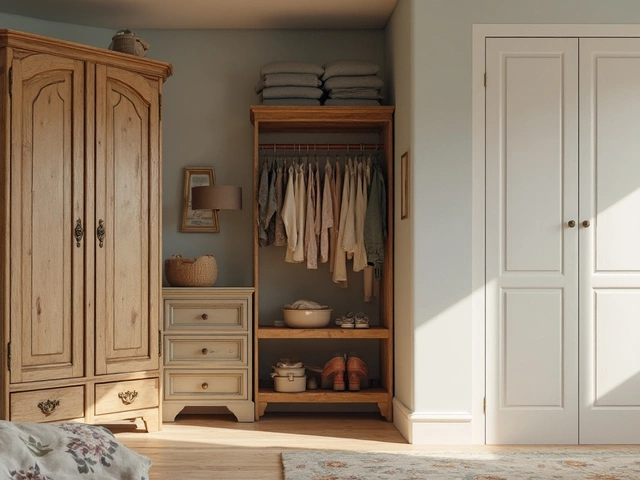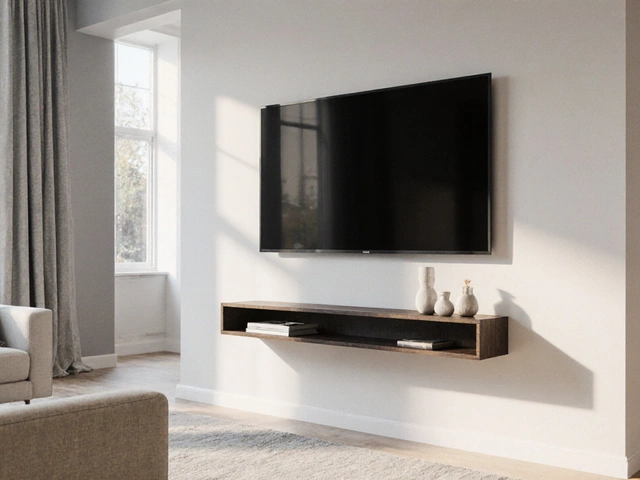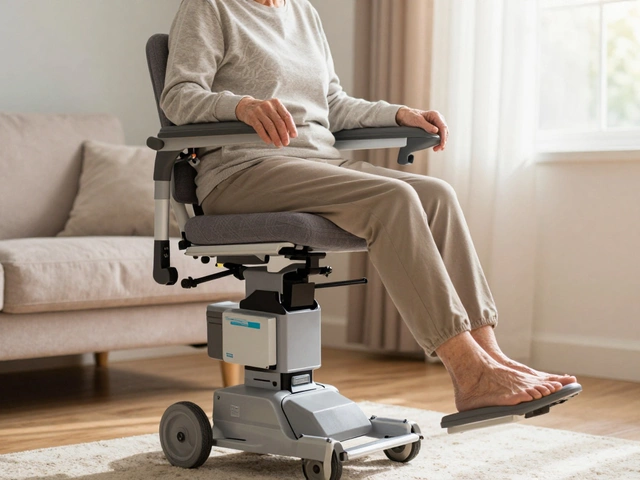Picture this: you're settling in for a hectic day at work or about to get lost in a new video game, and just as you're finding your groove—suddenly, your office chair betrays you. A slow descent, barely noticeable at first. By lunch, you're typing at chin height to your desk. It’s not a prank. Most of us just accept it and give the lever another pull, but is it normal for office chairs to sink over time, or is there a deeper story buried under that sinking sensation?
The Science Behind Sinking Chairs
Every office chair with adjustable height has a secret: a compressed gas cylinder (sometimes called a pneumatic or hydraulics cylinder) housed deep inside its base. This gas cylinder is the magic behind those satisfying moments when you press a lever to glide up or down. It works similar to the shock in the boot of your car. Gas—usually nitrogen—is trapped inside, pressing against a piston. When you pull the lever, you release the pressure so the seat can glide up and down your desired height. It sounds simple, and honestly, it’s pretty clever. But over months (or years) of up-and-down action, tiny problems add up.
Here’s the catch: the seal around the gas in the cylinder can wear out, especially in cheap chairs or with heavy daily use. Little by little, the chair struggles to hold your weight at a set height. Temperature swings, heavier loads, and even manufacturing quirks all play a part. According to data from several office supply studies, over 60% of chairs start showing “height creep” after just 18-24 months of regular use. That’s faster than most people expect.
Sometimes, the cylinder isn’t at fault. The base or the mechanism that locks the gas cylinder in place can wear down or slip. Imagine the locking teeth on an adjustable wrench rounding out—eventually, they just can’t bite anymore. Higher-priced ergonomic chairs tend to last longer because they use better materials, but even the best-known brands (think: Herman Miller or Steelcase) acknowledge this as a potential wear point.
What about static electric shocks or weird noises? These hint at extra wear or a compromised seal. If your chair gets “spongy” or wobbly when locked, it’s the gas cylinder or the locking mechanism getting tired. Air pressure inside these cylinders can leak out invisibly, and once enough is gone, gravity takes over. The engineering isn’t overly complex, but it’s built to survive daily abuse—not immortality.
Here’s a handy little table to break down the average lifespan for chair cylinders across price ranges and settings:
| Chair Type | Average Cylinder Lifespan | Notes |
|---|---|---|
| Budget Office Chair (< £50) | 6-18 months | Frequent wear, basic materials |
| Mid-range Office Chair (£50-£250) | 18-36 months | Beter build, moderate wear |
| High-End Ergonomic Chair (> £250) | 3-7 years | Durable, often replaceable |
| Gaming/Heavy Duty Chair | 2-5 years | Designed for more weight, but still subject to wear |
So, yes—most office chair sinking problems are just science doing its thing. If you’re constantly pulling that lever or refuse to buy yet another chair, you’re not alone. And there’s stuff you can do about it.
Why Does My Chair Always Sink? Everyday Causes and Triggers
It’s tempting to blame weight or bad luck, but the truth is, office chairs see action like few other bits of furniture. If you’re anything like me, you pop up and down dozens of times a day—meetings, coffee breaks, chasing after kids (or, in my house, convincing my wife, Cerys, that the remote isn’t hoarded under my seat yet again). All that movement adds up fast.
But the biggest factor by far? The quality of the gas cylinder seal. Cheap chairs tend to use inexpensive plastic or thin rubber. These tiny seals take a beating every time you sit, stand, or wobble side to side. Even a tiny tear or warp lets gas out over time. Warm air expands and cold air contracts, so those winter mornings when you plop down without pre-heating the room? That’s stress for your chair, too.
It’s not just about fancy engineering. Where you use your chair matters—a damp office, for example, invites rust. On the flip side, dry heated offices can crack seals faster. Sitting habits play a role, too. If you tend to drop into your seat from a height or lean back hard while thinking, that’s putting extra force on the locking mechanism and seals.
Let’s name-check a few triggers you might not expect:
- Rolling over thick carpet or debris: Adds strain on the central column.
- Over-tightening or fiddling with controls: Wears out the locking mechanism.
- Chair races (don’t pretend you’ve never tried): Sudden jolts break down the cylinder’s internals.
- Impatience: Using the adjusting lever while seated with full weight increases wear vs. adjusting before sitting down.
Some chairs carry weight ratings—exceeding those makes sinking more likely. If your chair is rock-solid in a shop but starts drifting at home, check the fine print for weight and usage frequency. The real kicker? Dust and grit can sneak in around the moving parts, especially if you don’t vacuum under the chair often. Dust eats away at seals and lubricants, making leaks more likely.
And don’t ignore manufacturing luck. Sometimes, a chair just leaves the factory with a cylinder that isn’t up to standard. I once had a fancy mesh-back chair collapse in a literal month—warranty covered it, but I still felt the betrayal deep in my soul. If your chair sinks early on, it’s not always something you did.
None of this means you’re doomed to a life of wobbly workdays. There are clear warning signs and even ways to delay—or fix—the inevitable.

Can You Stop a Chair from Sinking? Maintenance and Quick Fixes
If you’re tired of the sneak-attack descent, you have options. The first is damage control: regular, simple maintenance. Dust the base, check for wobbles, and—if you’re feeling productive—give the moving mechanisms a squirt of silicone spray (not WD-40, which can degrade rubber seals). But sometimes prevention isn’t enough, and you want a fix that lasts longer than a day.
The classic “hack” is the hose clamp or Jubilee clip trick. It’s a low-tech, high-satisfaction method that involves wrapping a metal clamp beneath your seat on the exposed portion of the gas lift, right where it meets the base. Tighten it so the cylinder can’t slide down. It locks your seat height where you want it. Does it look fancy? Nope, but it can keep you off the floor for months. Some people wedge a piece of PVC pipe around the cylinder for even more support, making the height permanent.
If you want your investment to last, though, replacing the gas cylinder is the gold standard. Cylinders aren’t universal—check the diameter and length before buying—but most mid-to-high-end office chairs are designed for easy swaps. Expect to pay anywhere from £12 for a cheap replacement up to £40 for a heavy-duty one. The hardest part? Getting the old cylinder out. You’ll need a mallet, a pair of locking pliers, and some solid YouTube encouragement. Undo the base, tap the old cylinder free, insert the new one, and bingo—your chair rises like a phoenix. Yes, I once did this in my living room with tools borrowed from my neighbour... no regrets!
If DIY isn’t your thing, specialist repair shops can do this in under an hour. Some brands even offer extended warranties or free replacements on cylinders if yours gives out early. Don’t toss the whole chair until you check. And don’t forget the small stuff: keeping the chair clean and not using it as a makeshift ladder can buy you a few more months of upright sitting.
Here’s a handy checklist for making your chair last longer:
- Vacuum around the base and wheels weekly
- Don’t exceed the chair’s weight limit
- Avoid slamming down in the seat
- Oil the mechanisms once every six months
- Adjust the height while NOT seated
- Inspect for wobbles or hydraulic leaks every few months
- Consider swapping the gas cylinder proactively every 2-3 years
Staying upright is easier when your chair is on your side. Maintenance might sound boring, but it beats shelling out for a whole new chair every year.
Should You Replace or Repair? Choosing the Right Path
So, you’re stuck with a chair that sinks the second you look away—or maybe you’re just tired of living with an always-drooping seat. Do you go all-in on repairs, or start shopping for something fancier? It depends on your budget, your patience, and how attached you feel to your current throne.
If the chair frame and seat are solid—no cracks, rips, or wobbles—swapping the cylinder is often the most cost-effective option. The price of a quality gas lift cylinder is usually less than 20% of a new chair, especially if you’re eyeing those plush ergonomic models. Many chairs actually use standardized parts, so it’s less hassle than it sounds. Plus, there’s something satisfying about a quick repair that breathes new life into an old favourite. (Trust me, Cerys wasn’t convinced until she realized she could adjust my ancient chair back to her own setting... domestic harmony restored!)
If your chair is cheap plastic, falling apart, or the cylinder costs nearly as much as an upgrade, then invest in a better chair. High-end brands often offer parts for a decade after sale, and yes, solid warranties that cover sinking. Got a receipt? Don’t be shy about using it—even if the chair is a couple of years old.
Some folks try to “live with” a sinking chair by stacking cushions or using booster pads. That’s usually a bad idea. Messes with your posture, raises your hips up too high, and pretty soon your back and knees will complain. It’s better to solve the root problem. Don’t forget: a well-fitted chair can help you avoid pain, boost productivity, and keep you from unconsciously slouching (the silent killer of office morale).
Ready to upgrade? Think about:
- Weight capacity — aim 20% above your body weight for extra security
- Warranty length on the gas cylinder
- Quality of the seat material and stitching
- Ease of cylinder replacement
- Customer reviews about lasting comfort and support
Paying a little more upfront often buys a lot more sitting time before you ever have to think about sinking again.

Insider Tips to Prolong the Life of Your Office Chair
It’s tempting to treat a chair like any other piece of furniture—set it and forget it. But these things are precision engineered for moving humans, and with a few tweaks, you can squeeze added years out of even a mid-level chair.
Start with placement. Avoid direct sunlight, which can bake seals and dry out lubricants. If your chair lives by a heater, try scooting it a metre away. Not always practical, but it can slow aging. Damp offices can be just as tough—wipe down metal bases every now and then to keep them rust-free.
Wheels are worth a mention. Dirt and hair wrapped around the casters puts strain on the whole support column. Pop the wheels off once a month (yes, most are just clipped in) and yank the worst of the debris free. A little care goes a long way with smooth rolling.
If you’ve become attached to a particular seat—like that classic mesh model you grabbed on sale—see if the manufacturer sells spare parts. Swapping out arm pads, lumbar supports, and yes, gas cylinders can keep you sitting comfortably for years, without the hassle (or landfill waste) of replacing the entire chair. Many new office chairs now come with QR codes for easy lookup of replacement parts.
And don’t forget posture. Getting the height and tilt just right means less shifting, less abuse to the mechanisms, and fewer times a day you’re pounding on that adjuster lever. Aim for your feet flat on the floor, hips slightly above knees, and screen straight ahead. Your back will love you—and so will your chair.
While it might seem like office chairs are disposable, a little human intervention makes a world of difference. I’ve seen folks get ten or more years out of a quality chair with minimal fuss. Sometimes, all it takes is five minutes, a clamp, or a careful swap—and you’re back on top of your office game, literally and figuratively. Next time your seat starts sneaking down, at least you’ll understand exactly what’s going on, why it happens, and how you can fight back.





